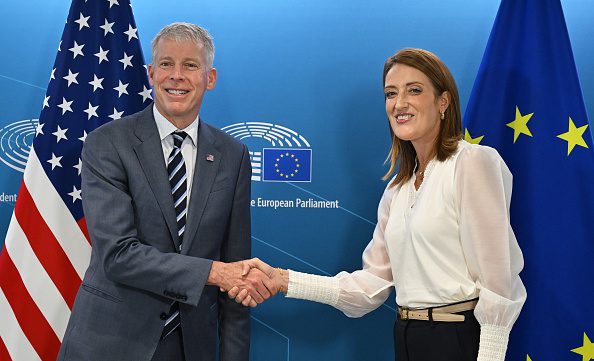
The media typically raises issues that generate interest, create rumors, and engage people in gossip.
Ultimately, their goal is to maximize viewership, revenue, and profits.
Therefore, issues such as the Jeffrey Epstein suicide case are at the top of their list of priorities. They provide exciting analyses of the public figures involved, and employ analysts and interviewers to provide insights into the story and shed light on various aspects.
Meanwhile, they neglect serious issues that only raise problems, despite their vital and pivotal importance. Most notably, the US debt crisis, food security, population explosion, and national threats.
We will address these issues in detail in the following paragraphs.
US debt crisis
The US debt crisis, also known as the “debt ceiling crisis,” is a recurring problem that arises when the US public debt reaches the legally permitted maximum, known as the “debt ceiling.” When the debt ceiling is reached, the US Treasury is not permitted to issue new debt above this limit. The US Congress must decide whether to raise or suspend this ceiling to avoid a government default.
Causes and Effects of the Crisis:
· Huge government spending: The federal government’s expenditures exceed its revenues, leaving it dependent on borrowing to finance its budget deficit.
· Political disagreements: The crisis is often exacerbated by sharp disagreements between the Democratic and Republican parties in Congress over spending and debt.
· Rising borrowing costs: Interest rate increases and inflation contribute to increased interest expenses on the debt.
Impact on the US and Global Economy:
Loss of confidence: If Congress fails to raise the debt ceiling, investors may lose confidence in the US’s ability to repay its debt, potentially leading to a withdrawal of funds from US financial markets.
Rising interest rates:
This could lead to higher interest rates on various investments, such as mortgages.
Economic slowdown:
The economy could slow significantly, and the federal government may struggle to meet its obligations, such as Social Security checks and medical care costs.
Global impact:
Given the US dollar’s status as the global reserve currency and US bonds’ status as a safe investment, any disruption in the US debt market could negatively impact the global economy.
Food Security in the United States
Food security in the United States means that all individuals have consistent access to sufficient, healthy, and nutritious food, enabling them to lead a healthy and active lifestyle. However, a significant percentage of American households are food insecure.
Major Causes of Food Insecurity in the United States:

Poverty and Low Income:
Limited income is the primary cause of food insecurity. Households with low or unstable incomes, such as low-wage earners, the unemployed, and people with disabilities, often do not have enough money to purchase sufficient, healthy, and nutritious food.
This problem is exacerbated by the overall rising cost of living, including housing, healthcare, and utilities.
Inflation and Rising Food Prices:
Recent increases in food prices have exacerbated the situation, making healthy foods more expensive and forcing households to choose cheaper, less nutritious options.
Demographic and Social Factors:
· Race and Ethnicity: Data show significant racial disparities in food insecurity rates. Households headed by African Americans, Latinos, Native Americans, and other minorities experience significantly higher rates of food insecurity than non-Latino white households. This reflects a history of systemic discrimination and economic disadvantages.
· Families with children: Households with children, particularly single-headed households, are more vulnerable to food insecurity.
· Elderly: Although older adults are generally less likely to experience food insecurity than younger adults, a significant proportion still experience it.
· Geographical areas: Food insecurity rates can vary by region. Rural areas and some urban areas (especially “food deserts” that lack large grocery stores that sell fresh, nutritious foods) experience higher rates.
Supply chain disruptions:
· The COVID-19 pandemic has exposed the fragility of food supply chains, leading to temporary shortages of some products and price increases.
· Natural disasters and climate change can also impact agricultural production and transportation, affecting food availability and prices.
Effects of Food Insecurity:
· Health Problems: Food insecurity is linked to malnutrition, including obesity resulting from the consumption of cheap, nutrient-poor foods, and increased rates of chronic diseases such as diabetes and heart disease.
· Deterioration in Educational Performance: It affects children’s ability to learn and concentrate in school.
· Psychological and Social Impact: It causes anxiety and stress for individuals and families, affecting their quality of life.
Population Explosion
Overpopulation is a complex issue that can negatively impact the national security of any country, including the United States. Although the United States does not experience a population explosion in the traditional sense as some developing countries, population growth, whether resulting from natural increase or migration, can pose challenges.
The Problem of Overpopulation in the United States and Its Implications:
Although the fertility rate in the United States is below replacement level (2.1 children per woman), population growth stems largely from both organized and unorganized migration. The problems and implications of overpopulation include:
· Pressure on Resources and Infrastructure: Population growth leads to increased demand for natural resources, such as water, energy, and arable land. It also places pressure on existing infrastructure, such as roads, schools, hospitals, and sewage networks, potentially leading to deterioration of services and significant expansion costs.
· Economic Impact: Population growth can increase competition for jobs, particularly low-skilled jobs, potentially raising unemployment rates in some sectors. Meeting the needs of population growth requires significant investments in infrastructure and services, which can impact spending in other areas.
· Social Challenges: Rapid population growth, especially if accompanied by demographic changes (such as a youth bulge or shifting ethnic composition), can lead to social tensions and conflicts over resources or political representation.
· Environmental Impact: Population growth contributes to increased pollution (air, water, and soil) and increased carbon emissions, exacerbating climate change, which itself represents a long-term security threat.
National Threats
There are numerous threats to U.S. national security, some of which go beyond population growth, but encompass broader aspects:
Great Power Competition:
· China: China is the United States’ primary strategic competitor and poses a multifaceted threat encompassing economic, military, cyber, and global influence. China seeks to challenge U.S. leadership and the current international order.
· Russia: Russia continues to pose a threat through its regional aggression (such as the war in Ukraine), its interference in the internal affairs of other countries, and its nuclear and cyber capabilities.
· Iran and North Korea: They pose a regional and global threat through their nuclear and missile programs, their support for militant groups, and their cyberattacks.
Terrorism and Extremist Groups:
International and domestic terrorism remain a serious threat, with extremist groups (such as ISIS and al-Qaeda) seeking to launch attacks inside and outside the United States. Domestic violent extremism is also a growing concern.
Cyber Threats:
Cyberattacks by hostile states and criminal groups against critical infrastructure, government networks, and U.S. businesses are on the rise, threatening economic and national security.
Illegal Immigration and Border Security:
Continued illegal immigration poses a challenge to national security, as it strains domestic resources and allows unauthorized individuals, including suspected terrorists or criminals, to cross borders.
Climate Change:
Climate change poses a multiplier threat to national security, increasing the frequency of natural disasters (such as droughts, floods, and wildfires), causing displacement, straining resources, and negatively impacting military bases and infrastructure.
Global Health Crises:
As the COVID-19 pandemic has demonstrated, pandemics can pose a serious threat to national security through their impact on the economy, health infrastructure, and social cohesion.
Political division and internal polarization:
Political polarization and internal divisions can weaken the United States’ ability to confront external challenges and undermine confidence in democratic institutions.
All these problems require us to deal with them with transparency and clarity, and to unify our efforts, cooperate, and rise above divisions and differences.
Also Read:
l a-self-driving-tesla-taxi-crashes-into-a-parked-vehicle
l a-chinese-humanoid-robot-cooks-using-virtual-reality
l brain-computer-interfaces-when-telepathy-becomes-a-technological-reality
l will-tiktok-go-bankrupt-after-the-new-us-decisions
l from-love-to-deportation-the-tangled-saga-of-elon-musk-and-donald-trump




